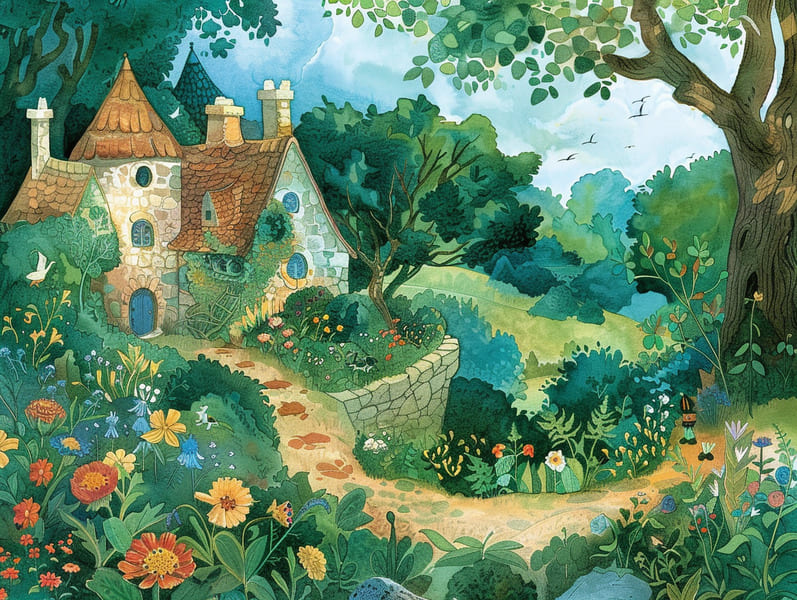
Grimm's fairy tales have enduring presence. These stories have been spoken from one generation to the next far before they were ever published. They developed from a variety of civilizations, including Indigenous traditions. They were initially transmitted among elders, often carrying themes and messages concerning the societal norms and beliefs of the time.
The Grimm brothers, Jacob and Wilhelm (the Grimm brothers), were among the first to gather and publish many of these beloved fairy tales. Their published works, "Grimm's Story Collection," included narratives like "Ashenputtel," "The Bread Crumb Trail," and "Snow White," which have since become cornerstones in the world of classic fairy tales. Similarly, Hans Christian Andersen's enchanting narratives, such as "The Sea Maid," and "The Story of the Ugly Duckling," have stolen hearts worldwide, cementing their place in the pantheon of iconic fairy tales.
Though they are centuries old, these stories remain as significant as ever, especially as children's bedtime stories. These delightful tales are now available in numerous formats, including artistically illustrated books, charming animations, and online fairy tales.
Their ongoing significance can be ascribed to several delightful features:
Important Morals: Traditional fairy tales often convey important moral lessons. Narratives like "The Wolf and the Liar" teach the merit of integrity, while "The Story of the Tortoise and the Hare" point out the merits of tenacity and unassuming nature. These stories offer young readers clear distinctions between good and bad, molding their moral compass in a mild yet important way.
Compassion and Knowledge: Fairy tales frequently illustrate personalities facing tests and troubles, stimulating audiences to relate with their struggles and celebrate their triumphs. For instance, "Beauty's Beast" teaches us the merit of seeing beyond the surface to acknowledge the real person of a being, developing kindness and perception.
Cultural Perception: Many timeless fairy tales are imbued with the cultural contexts from which they sprang. Understanding these stories can provide informative snapshots into different traditions, cultivating a sense of world understanding and comprehension.
Fantasy and Innovation: The magical elements in old fairy tales—fairy godmothers—fire up children’s dreams. These fairy tales take readers to mythical realms, unleashing imaginative dreams and a sense of awe that endures a lifetime.
Old fairy tales are not only charming but also educational. They provide entrancing tools in enhancing various thinking and feeling skills in children. When fairy tales are recited, they nurture language acquisition by offering new words and sophisticated sentence structures. This practice also strengthens auditory perception and attention, as the young remain attentive, excited to see what happens next.
Furthermore, debating the themes and characters of classic fairy tales can cultivate intellectual skills and cognitive skills. Children are guided to detect patterns, expect results, and comprehend cause and effect. These conversations also benefit young readers express their thoughts and feelings, strengthening their emotional intelligence.
In today’s modern era, the prevalence of free fairy tales online has made these fairy tales more obtainable than ever. Online resources and applications give huge assortments of timeless fairy tales that can be seen or played anytime, anywhere. Fairy tales read out loud are particularly widespread, presenting an entertaining method for young readers to delight in these captivating stories. Voice books and narrated videos guide characters and settings to life, often supplemented by charming audio effects and melodies that enrich the storytelling journey.
The unending appeal of ancient fairy tales lies in their ability to adapt to current eras while holding onto their main lessons. Contemporary adaptations of these tales often integrate more varied characters and modern settings, making them meaningful to today’s audience. However, the underlying themes of courage, benevolence, and fair-mindedness remain unchanged, continuing to move kids of all ages.
Classic fairy tales also offer a sense of warmth and familiarity. They render a systematic narrative with a definite beginning, middle, and end, often wrapping up with the conclusion of conflicts and the triumph of righteousness over wickedness. This constancy can be easing for young ones, granting a sense of solidity in an always shifting world.
Classic fairy tales continue to charm and coach new generations, maintaining their grace and pertinence in modern society. As bedtime stories for kids, they share a perfect blend of captivation and insight, enhancing moral values, empathy, and creativity. The availability of free fairy tales online and the likability of fairy tales voiced guarantee that these ancient tales remain accessible to new generations.
By keeping and narrating these fairy tales, we continue to commemorate the rich tapestry of cultural heritage and cultural heritage. Whether you are perusing a vibrantly illustrated book, delving into a virtual collection, or listening on an audiobook, the splendor of classic fairy tales is always within reach. These tales show us of the invariable nature of storytelling and its ability to bind us across eras and regions.
If you are exploring a gorgeously illustrated book, experiencing a online library, or listening through an read-aloud story, the elegance of classic fairy tales is always these guys within reach.
These tales demonstrate of the ageless effect of fairy tales and its ability to hold us together across generations and cultures, establishing a link that charms and informs alike.